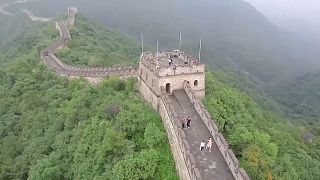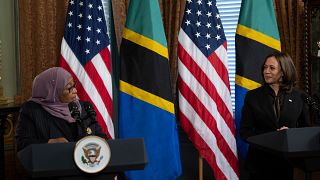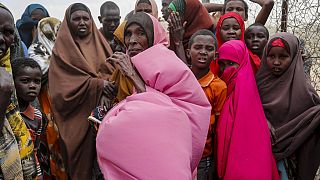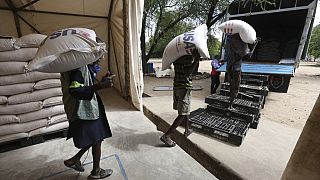Culture
UNESCO's World Heritage Committee will meet next month to discuss which new sites should get a place on its prestigious list and which should be removed.
Seven face being added to the UN body's 'Danger List' and two could be delisted entirely, as both human action and natural disasters threaten the character of these special places.
The World Heritage List includes both natural and cultural sites that are judged to have outstanding value for the whole of humanity.
From the immense Great Wall of China, to the lush green paradise of the Royal Botanic Gardens, Kew, the prestigious accolade is a sign to nations that these treasures must be cared for and preserved for future generations.
After the COVID-19 pandemic cancelled its 2020 meeting, the World Her itage Committee is scheduled to meet in China next month to judge which new sites should be added to the list.
However, the session will also discuss current World Heritage Sites considered to be under threat.
In a report released last week, UNESCO recommended that seven should be included on its so-called 'Danger List' - which details places facing conditions which could ruin the very reasons they were originally awarded the status.
This can include both manmade problems, like war and over-development, or natural disasters that have altered the character of the site.
UNESCO has also proposed that two sites are removed from the World Heritage list completely.
This is a very unusual step - and it's incredibly rare for two sites to face this action at a single session.
In its entire history, only two have ever been delisted: the Arabian Oryx Sanctuary in Oman in 2007, due to oil and gas exploration, and the Dresden Elbe Valley in Germany in 2009, after a bridge was built across the site.
"Delisting actually should never occur because the duty is given to us, meaning the whole international community, meaning you and me, everybody on this planet, that we need to preserve those sites which are so unique, so special, they have outstanding universal values. So, we need to transmit them to the generations which come after us," says Mecthild Rössler, director of the World Heritage Center.
"Now, if we propose delisting, it's really a very radical step."
The sites facing delisting are the Selous Game Reserve in Tanzania, due to a dam being built on the land, and in the UK, Liverpool's Maritime Mercantile City.
The city became the British Empire's major port in the 18th and 19th centuries, and the grand buildings constructed at the time reflect that.
But UNESCO has raised concerns about redevelopment of the docklands, saying modern buildings have spoilt its character.
"We don't want to block development, but it really needs to be aligned with the listing of the site and that apparently failed to align that in Liverpool, despite the dialogue we had with the city over the years. And that is very regretful for me," says Rössler.
Potentially facing a spot on the List of World Heritage in Danger is the Great Barrier Reef.
The UNESCO report says "there is no possible doubt" the network of colourful corals off Australia's northeast coast is "facing ascertained danger."
But the move has caused upset in Australia, with government officials rejecting the UN body's conclusions.
In a press conference last week, Environment Minister Sussan Ley said the decision had been made "without due process".
"It was made on the basis of a desktop review. It hasn't even used the latest data," she said.
But Rössler insists the dangers outlined are real.
"We followed completely the procedures and the data we used is the data Australia gave to us," she says.
"One has to acknowledge Australia really has among the best scientists in the world, including on all the phenomena which we see there, coral bleaching, etc., but there are issues which need to be addressed at the reef, and that is among them are the water quality, etc."
The other six sites under consideration for the Danger List are Venice and its lagoon, which is being damaged from over-tourism, the Volcanoes of Kamchatka in Russia, Budapest, including the Banks of the Danube, the Buda Castle Quarter and Andrássy Avenue, the Natural and Cultural Heritage of the Ohrid region in Albania and North Macedonia, the W-Arly-Pendjari Complex in West Africa, and Kathmandu Valley in Nepal.
But Rössler insists inclusion on the list can actually be a positive step.
"It is misunderstood that the danger list is not, so to say, a wreck list to put the government into a difficult situation. It should be, on the contrary, understood that the whole world is there to work together to safeguard these sites," she explains.
"And the Great Barrier Reef is among the best World Heritage and most emblematic World Heritage sites. And I think this is where we need to work together instead of against each other."
Inclusion on the Danger List is a step towards complete removal.
But the UNESCO proposals are just that - proposals. It will be down to the committee itself to decide whether any of these sites should be given Danger List status, or worse, delisted entirely.
The session will be chaired from Fuzhou, China and will take place online from 16 to 31 July.












01:17
UNESCO inscribes 26 new sites on World Heritage list
02:19
Abuja residents celebrate Igbo festival in grand style
00:51
Marrakech national festival: honoring the legacy of popular arts
01:24
French parliament votes to return sacred "talking drum" to Ivory Coast
02:20
Young designers grace the runway at Fashion Finest Africa’s show in Lagos
02:19
Morocco sees surge in Chinese tourists